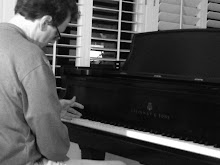Chorale #2
I've returned to the study of counterpoint. I've spent some time with Giancarlo Aquilanti looking at Palestrina and church modes. I'm tempted to transcribe several of Palestrina's chorales for piano and perform them. Here is an excerpt of the Kyrie from his Missa Brevis.
Sometimes I wonder what the world would be like without Bach. I suppose it's wrong to give him credit for the tonal language that defined classical music for the next couple hundred years. But if one were to identify the Dante of tonality, Bach would certainly be a likely choice. Without Bach, or perhaps without the clear definition of the tonal language, is it possible the polyphony of Palestrina would have evolved differently?
It's almost easier for me to make the jump to polytonality from polyphony than from tonality. With polyphony and church modes, you don't have the strong cadences that typically define a tonal center. And hence you have the opportunity to create more ambiguity, more nuance. I wonder whether composers such as Stravinsky and Ives attempted to build the bridge back to Palestrina and polyphony. My initial work on the Inferno cycle reflects my own desire to explore models of polytonality.
I recall the stories of how often Robert Schumann would go back to the Well Tempered Clavier to study counterpoint. Certainly an understanding of counterpoint and motion in music is as relevant today as centuries before. Motion seems fundamental to music, and without an understanding of dissonance and counterpoint, I wonder whether true motion is possible. I would like, therefore, to spend more time learning about counterpoint, and I want to understand the polyphony of Palestrina.
At any rate, my Chorale #2 is nothing so grand, but rather a simple exercise in counterpoint and church modes. I find the piece sounds slightly modern -- I don't always prepare the dissonance (fourths, seconds, sevenths) for example. I had a lot of fun developing the subject.
Chorale #2
Chorale #2 score
Chorale #2 original score
Sometimes I wonder what the world would be like without Bach. I suppose it's wrong to give him credit for the tonal language that defined classical music for the next couple hundred years. But if one were to identify the Dante of tonality, Bach would certainly be a likely choice. Without Bach, or perhaps without the clear definition of the tonal language, is it possible the polyphony of Palestrina would have evolved differently?
It's almost easier for me to make the jump to polytonality from polyphony than from tonality. With polyphony and church modes, you don't have the strong cadences that typically define a tonal center. And hence you have the opportunity to create more ambiguity, more nuance. I wonder whether composers such as Stravinsky and Ives attempted to build the bridge back to Palestrina and polyphony. My initial work on the Inferno cycle reflects my own desire to explore models of polytonality.
I recall the stories of how often Robert Schumann would go back to the Well Tempered Clavier to study counterpoint. Certainly an understanding of counterpoint and motion in music is as relevant today as centuries before. Motion seems fundamental to music, and without an understanding of dissonance and counterpoint, I wonder whether true motion is possible. I would like, therefore, to spend more time learning about counterpoint, and I want to understand the polyphony of Palestrina.
At any rate, my Chorale #2 is nothing so grand, but rather a simple exercise in counterpoint and church modes. I find the piece sounds slightly modern -- I don't always prepare the dissonance (fourths, seconds, sevenths) for example. I had a lot of fun developing the subject.
Chorale #2
Chorale #2 score
Chorale #2 original score

